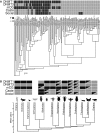Evolution of DNA Methylation across Insects
- PMID: 28025279
- PMCID: PMC5400375
- DOI: 10.1093/molbev/msw264
Evolution of DNA Methylation across Insects
Erratum in
-
Evolution of DNA Methylation across Insects.Mol Biol Evol. 2017 Apr 1;34(4):1025. doi: 10.1093/molbev/msx067. Mol Biol Evol. 2017. PMID: 28333313 Free PMC article. No abstract available.
Abstract
DNA methylation contributes to gene and transcriptional regulation in eukaryotes, and therefore has been hypothesized to facilitate the evolution of plastic traits such as sociality in insects. However, DNA methylation is sparsely studied in insects. Therefore, we documented patterns of DNA methylation across a wide diversity of insects. We predicted that underlying enzymatic machinery is concordant with patterns of DNA methylation. Finally, given the suggestion that DNA methylation facilitated social evolution in Hymenoptera, we tested the hypothesis that the DNA methylation system will be associated with presence/absence of sociality among other insect orders. We found DNA methylation to be widespread, detected in all orders examined except Diptera (flies). Whole genome bisulfite sequencing showed that orders differed in levels of DNA methylation. Hymenopteran (ants, bees, wasps and sawflies) had some of the lowest levels, including several potential losses. Blattodea (cockroaches and termites) show all possible patterns, including a potential loss of DNA methylation in a eusocial species whereas solitary species had the highest levels. Species with DNA methylation do not always possess the typical enzymatic machinery. We identified a gene duplication event in the maintenance DNA methyltransferase 1 (DNMT1) that is shared by some Hymenoptera, and paralogs have experienced divergent, nonneutral evolution. This diversity and nonneutral evolution of underlying machinery suggests alternative DNA methylation pathways may exist. Phylogenetically corrected comparisons revealed no evidence that supports evolutionary association between sociality and DNA methylation. Future functional studies will be required to advance our understanding of DNA methylation in insects.
Keywords: DNA methylation; molecular evolution.; phylogenetic comparisons; social behavior; whole genome bisulfite sequencing.
© The Author 2016. Published by Oxford University Press on behalf of the Society for Molecular Biology and Evolution.
Figures




References
-
- Bestor TH, Verdine GL. 1994. DNA methyltransferases. Curr Opin Cell Biol. 6:380–389. - PubMed
Publication types
MeSH terms
Grants and funding
LinkOut - more resources
Full Text Sources
Other Literature Sources
Molecular Biology Databases

